International Observation Project OHMAN on the
International Space Station
— Automatic linkage of the MAXI all-sky X-ray monitor and the NICER telescope for prompt observation of new X-ray stars —
October 17, 2022 (JST)
RIKEN
Chuo University
Nihon University
Aoyama Gakuin University
Japan Aerospace Exploration Agency
The International Collaborative Research Group* consists of Dr. MIHARA Tatehiro (Senior researcher at the High Energy Astrophysics Laboratory, Pioneering Research Division, RIKEN), Dr. IWAKIRI Wataru (Assistant Professor at the Faculty of Science and Engineering, Chuo University), Dr. NEGORO Hitoshi (Professor at the Faculty of Science and Engineering, Nihon University), Dr. SERINO Motoko (Assistant Professor at College of Science and Engineering, Aoyama Gakuin University), and Dr. NAKAHIRA Satoshi (Chief Scientist at the Institute of Space and Astronautical Science, Japan Aerospace Exploration Agency (JAXA)), started OHMAN (on-orbit hookup of MAXI and NICER, also known as Orbiting High-energy Monitor Alert Network), a prompt observation project for X-ray emission sources on the International Space Station (ISS), on August 10, 2022, and successfully performed a coordinated observation on September 13.
The OHMAN project links instruments on the International Space Station (ISS) to provide real-time observations. The project links MAXI[1], an all-sky X-ray monitor, and NICER[2] of the U.S. National Aeronautics and Space Administration (NASA), which specializes precision observations with a narrow field-of-view. This project was sponsored by the Japan-US Open Platform Partnership Program (JP-US OP3), which is a framework for Japan and the US to cooperate in maximizing ISS utilization and is based on an April 2021 agreement.
Previously, MAXI data had been analyzed on Earth, then information about sudden X-ray phenomena was emailed to other satellites for follow-up observation. This took more than three hours from the discovery until the follow-up. With OHMAN, information on a new X-ray star emergence is processed by MAXI on a laptop PC aboard the ISS then forwarded to NICER. This enables on the ISS follow-up observations without supports of a ground base. This creates an international observatory capable of wide-area discoveries and detailed follow-up observations on the ISS, allowing discoveries to be followed up within ten minutes.
Future OHMAN observations are expected to identify MAXI-unidentified soft X-ray transients (MUSSTs), which had been detected by MAXI but were not followed up.
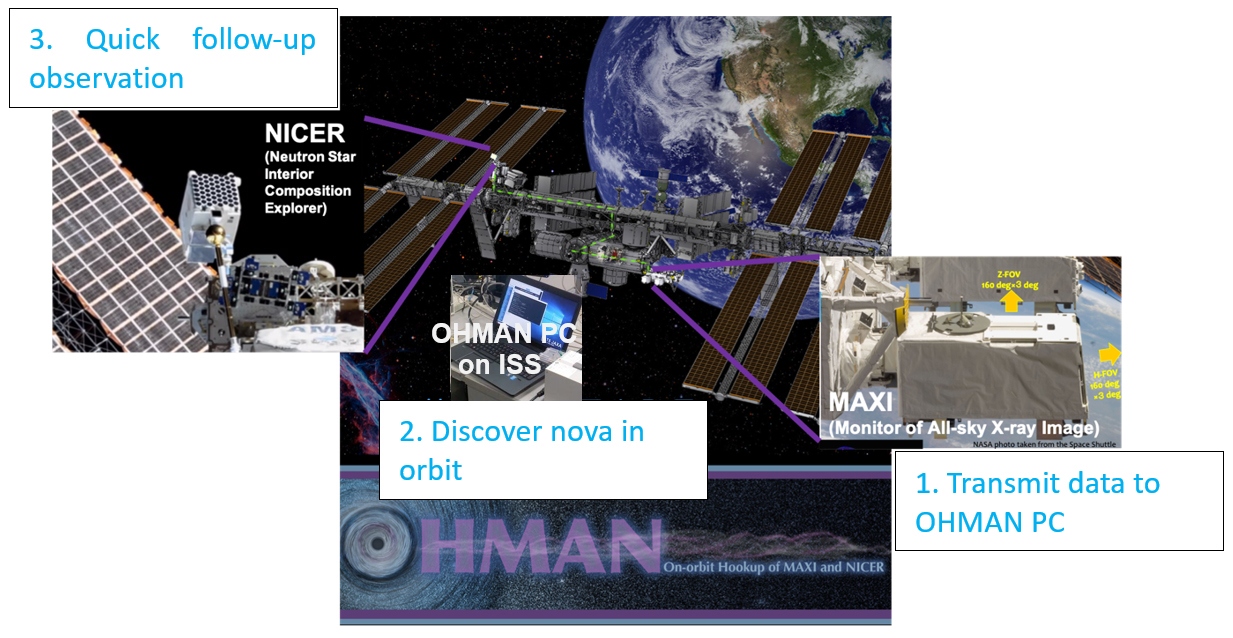
Conceptual drawing of the MAXI-NICER orbital coordination per OHMAN© NASA/JAXA
(addition to cover page of NASA/GSFC OHMAN Proposal)
* International Collaborative Research Group
- MIHARA Tatehiro, Senior researcher
- TAMAGAWA Toru, Principal Investigator
- Tamagawa High Energy Astrophysics Laboratory, Pioneering Research Division, RIKEN
- IWAKIRI Wataru, Assistant Professor
- Department of Physics, Faculty of Science and Engineering, Chuo University
- (Visiting Researcher at the Tamagawa High Energy Astrophysics Laboratory, Pioneering Research Division, RIKEN)
- NEGORO Hitoshi, Professor
- Department of Physics, College of Science and Technology, Nihon University
- SERINO Motoko, Assistant Professor
- Department of Physical Sciences , College of Science and Engineering, Aoyama Gakuin University
- NAKAHIRA Satoshi, Chief Scientist
- Institute of Space and Astronautical Science, Japan Aerospace Exploration Agency (JAXA)
- Exposed Facility Experiment Team, JEM Utilization Center, Japan Aerospace Exploration Agency (JAXA)
- MAXI Team in Japan
- RIKEN, JAXA/ISAS, Tokyo Institute of Technology, Nihon University, Kyoto University, Aoyama Gakuin University, University of Miyazaki, Chuo University, Ehime University
- U.S. National Aeronautics and Space Administration (NASA)
- Goddard space flight center (GSFC)
- NICER Team Representative, Keith Gendreau
- ISS team, Johnson Space Center (JSC)
Research Support
The following research was supported by the FY 2017 JAXA/ISAS Small-scale project OHMAN-JP (On-orbit Hookup of MAXI and NICER – Japan), the Japan Society for the Promotion of Science (JSPS) Grant-in-Aid for Scientific Research (B): “Revealing MAXI unidentified short transient by prompt follow-up” (Principal Investigator: MIHARA Tatehiro) , “Advanced study on short X-ray transients with MAXI alerts” (Principal Investigator: MIHARA Tatehiro), JSPS Grant-in-Aid for Scientific Research on Innovative Areas (Research area proposal type)“Genesis of Gravitational waves physics and astronomy” (Collaborative Investigator: MIHARA Tatehiro); JSPS Grant-in-Aid for Young Scientists (B) “Observational study of nucleosynthesis in X-ray superburst using the MAXI-NICER cooperation” (Principal Investigator: IWAKIRI Wataru), the JSPS Grant-in-Aid for Scientific Research (C) “On-orbit Hookup of MAXI And NICER for exploring and localizing X-ray counterparts of gravitational wave sources” (Principal Investigator: SERINO Motoko), JSPS New Academic Area Research (Research Area Proposal Type) “Construction of assistant observation systems for continuous gravitational wave candidates using microsats and MAXI-NICER collaboration” (Principal Investigator: IWAKIRI Wataru), and RIKEN's Program for Special Postdoctoral Researchers (SPDR) (FY 2016 – 2017: IWAKIRI Wataru).
1. Background
Monitor of All-sky X-ray Image (MAXI) on the International Space Station (ISS) was proposed by RIKEN and has discovered 34 new celestial bodies through continuous observations since its launch in August 2009. Fourteen of these are black holes. However, some of the new celestial bodies remain unidentified. In particular, a group of rapidly dimming sources shine only within MAXI's 90-minute scan and disappear by the time follow-up observations can be made with the Swift satellite XRT instruments a few hours later (Figure. 1). We call these MAXI unidentified short soft X-ray transient (MUSST) [3]. Recently, it has been suggested that one of the MUSST objects is a supernova explosion of a type predicted by theory but never observed, in which a black hole or neutron star[4] enters the core of a star and causes a supernova[5]. Thus, MUSST celestial bodies may be completely new astronomical phenomena. However, while MAXI has a wide field of view, its positioning accuracy is poor. More precise position information is necessary for detailed observations to study their true nature with large telescopes and satellites. Therefore, it is necessary to pinpoint the positions of MUSST objects and make follow-up observations before they disappear.
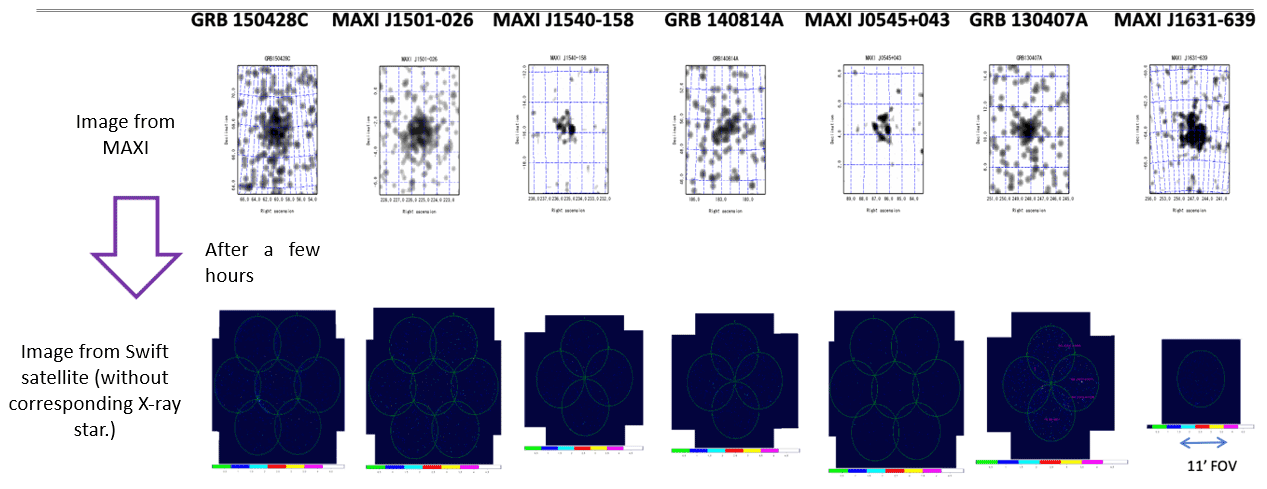
credit:RIKEN
Figure. 1: Examples of MUSST objects identified by MAXI
MAXI detected these example objects, shown in the upper figures. However, in the follow-up observations by the Swift satellite about half a day later, they were not detected at all, as shown in the lower figures.
2. Research Methodology and Results
MAXI data have been analyzed at a ground station, then potentially useful information is sent by email or other means to a satellite for follow-up observations. Because of the manual processing involved, this sequence of events can cause a delay of several hours. This will remain true until MUSST detection is fully implemented. However, the ISS carries two X-ray astronomy instruments, MAXI (Japan) and NICER (U.S.). MAXI is a wide-field monitor that detects X-ray phenomena over a wide but shallow field of view. NICER is a tracking X-ray telescope with a narrow field of view and no ability to detect prominences, but it can make very detailed observations. Currently, these two instruments are controlled independently from the ground. If these instruments, with different yet complementary characteristics, could work together, an innovative international observatory would be realized on the ISS to detect sudden phenomena in the x-ray band and immediately make detailed follow-up observations. The MAXI team in Japan and the NICER team in the U.S. launched the OHMAN project to realize this goal.
To achieve this, we installed the MAXI data nova detection software previously used on Earth on an ISS PC so that information on sudden phenomena could be transmitted directly to NICER automatically. No human intervention is required, and short-duration events will be observed in detail within ten minutes. (The final delay target is within two minutes.)
Preparations for OHMAN by NASA/JSC (the ISS team) and JAXA (the Exposed Facility Team) began in November 2020, and OHMAN became operational on May 26, 2022. Then, after thirteen days of verification, test operations were carried out for 2 and a half months. On August 10, OHMAN started normal operation. On September 13, MAXI detected an X-ray burst from the globular cluster M 15. NICER made automatic observations after 5 minutes and 30 seconds (Figure. 2). Since the X-ray burst was short this time, the burst had gone out when the NICER started observation. However, this event realized the prompt follow-up observation and was a large advance towards future observations.
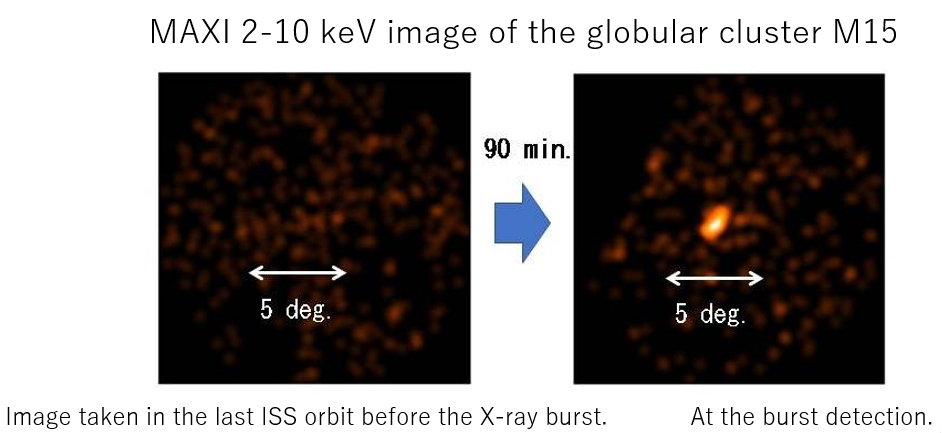
credit:RIKEN
Figure. 2: MAXI images of M15 before the X-ray burst and at the burst detection.
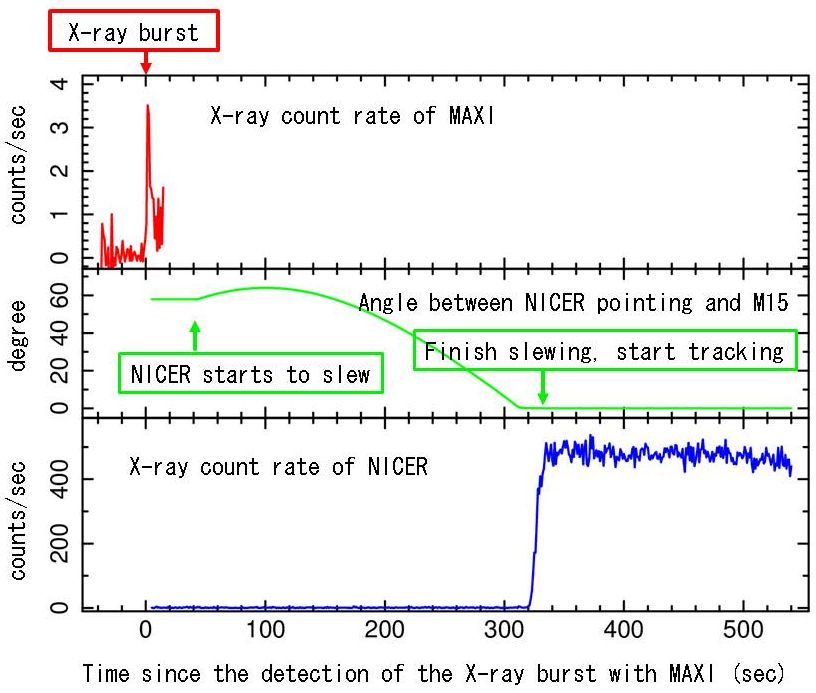
credit:RIKEN
Figure. 3: Time flow from the detection of the X-ray burst to the NICER observation.
(upper) X-ray intensity with MAXI. (middle) movement of NICER from the trigger time 0 sec. (lower) X-ray count rate of NICER. NICER detected M15 after 330 sec. The X-ray burst had ended by that time. 430 counts/sec is the normal X-ray count rate from M15. It corresponds to 0.07counts/sec with MAXI.s
3. Future Expectations
The accuracy of the OHMAN operation will be improved by parameter adjustments especially for the frequent solar flares since 2022 April. Although no new MUSST objects have been detected since implementation, MUSST may include undiscovered gamma-ray bursts caused by ancient explosive events by the first stars in the universe. The project is also expected to detect X-ray bursts caused by runaway nuclear fusion reactions on the surface of neutron stars, including superbursts with unusually long durations and stellar flares that are several thousand to several hundred million times larger than solar flares. These have been difficult to observe in detail from their initiation. MAXI operation has been approved through December 2024, and future prompt, coordinated observations are expected.
4. Supplementary Explanations
[1] All-sky X-ray monitor, MAXI
This is a JAXA/Kibo Utilization Center device attached to the Exposed Facility of the Japanese Experiment Module "Kibo" on the International Space Station. The proposal was adopted in 1998 by Masaru Matsuoka, a principal investigator at RIKEN's Cosmic Radiation Laboratory. Currently, operation and data analysis are being continued by members of the MAXI team, which consists of 12 domestic institutions and is led by the High Energy Astrophysics Laboratory. All-sky observations began on August 15, 2009, and the observation data are immediately available from RIKEN (http://maxi.riken.jpExternal link). In 13 years, MAXI discovered 34 X-ray novae, 14 of which were newly discovered black holes. The number of BH binary star discoveries by a single satellite/instrument ranks second all-time, behind the 15 discoveries by the U.S. X-ray astronomy satellite (RXTE). MAXI stands for Monitor of All-sky X-ray Image.
[2] NICER
This is the NASA/GSFC (Goddard space flight center) X-ray telescope aboard the International Space Station, U.S.S. truss part. It started observing in July 2017. Operations are being conducted by the NASA/GSFC NICER team, led by Keith Gendreau. NICER stands for Neutron star Interior Composition ExploreR.
[3] MUSST
MUSST stands for a MAXI unidentified short soft X-ray transient. These are short soft X-ray transient bodies that were not detected by the gamma-ray satellite but by MAXI in only one scan. The corresponding source objects were not detected despite follow-up observations by the Swift satellite. Since the exact location of the X-ray star could not be determined, it could not be followed up with visible light or other means, and it remains unidentified. The true nature of the MUSST could be an X-ray flash (the X-ray version of a gamma-ray burst) or a flare from a nearby dMe star. Or it could be a new astronomical phenomenon, such as a rapid nova explosion on a heavy white dwarf or a gamma-ray burst from the first star, the first star in the universe. Prompt observation in soft X-ray is necessary to understand the nature of MUSST. Therefore, a study by OHMAN is awaited. MUSST stands for MAXI unidentified short soft X-ray transient.
| Source name | [Crab]1) | Discovery report2) | Swift follow-up observation | |
|---|---|---|---|---|
| GRB 180829A | 0.071 | GCN 23186 External link |
after16h | |
| MAXI J0126−745 | 0.024 | ATel 12833 External link |
42h | 1 day long (quasi) |
| GRB 161123A | 0.15 | GCN 20203 | 6h | |
| MAXI J0636+146 | 0.051 | ATel 9707 | 4h | 2 orbits long (quasi) |
| MAXI J0758−456 | 0.15 | ATel 8983 | 5h | 0.5mC3) CV4)(quasi) |
| MAXI J1501−026 | 0.44 | ATel 7954 | 2h | |
| GRB 150428C | 0.16 | GCN 17772 | 5h | |
| MAXI J1540−158 | 0.1 | GCN 17568 | 50h | |
| MAXI J0511−522 | 0.014 | ATel 7200 | 12.5h | 10h long (quasi) |
| GRB 140814A | 0.23 | GCN 16686 | 6h | (*) |
| MAXI J0545+043 | 0.2 | ATel 6066 | 26h | |
| GRB 130407A | 0.17 | GCN 14359 | 16h | |
| MAXI J1631−639 | 0.12 | ATel 3316 | 26h | |
1)Crab:Unit of X-ray intensity. The intensity of the Crab nebula is 1 Crab.
2)GCN:Gamma-ray burst coordinated network.
ATel:Astronomer’s Telegram.
The number after GCN and ATel is the issue number.
3)mC:milli Crab. 1 mCrab is 1/1000 Crab.
4)CV:Cataclysmic Variable. Contact binary of a white dwarf and a normal star.
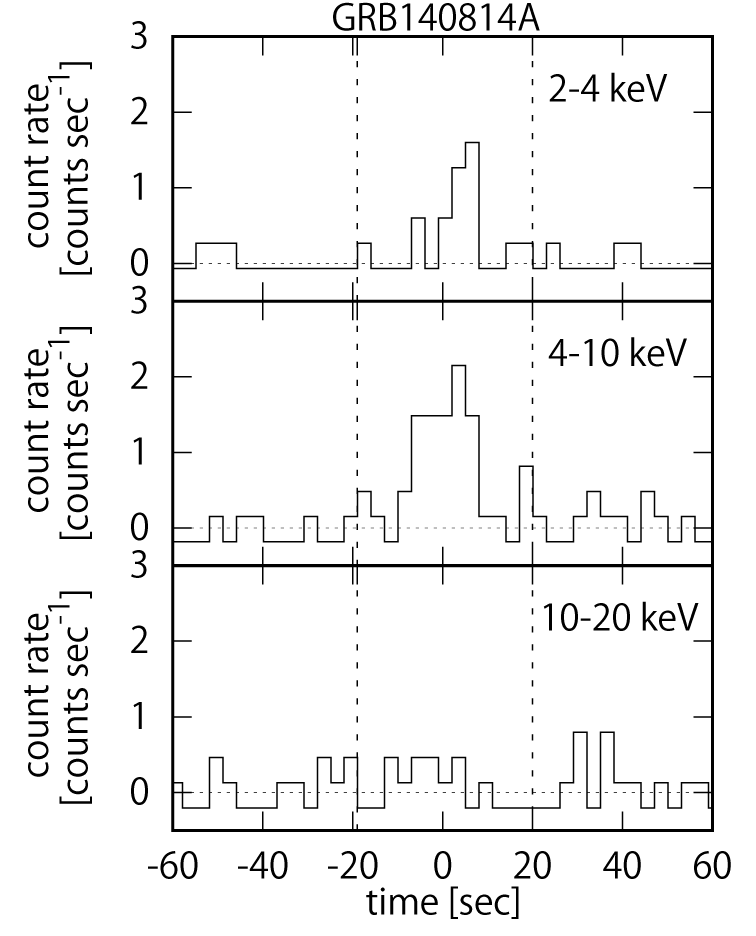
credit:RIKEN
Figure. 4: Examples of MUSST object
MAXI scan light curve for GRB 140814A (*). Curves between dotted lines are the scan. This was reported as a GRB but not in fact, because there was no flux at 10-20 keV (the emission was soft) and some other properties were different from typical GRBs.
(*) A startling report was made that GRB 140814A is a Thorne-Żytkow object. This is the result of a compact star, such as a black hole, that evolved earlier in the binary system and, as a result of the shortening of the binary distance, plunged into the companion star, spiraled in through the companion star due to friction, and finally merged with the core of the companion star at the center 300 years later, causing a gravitational collapse supernova. An observational paper by VLA, Keck. Dong+, Science 373, 1125 (issue dated 9.3.2021)
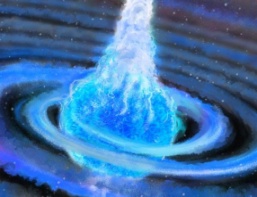
credit:caltech
[4] Neutron star
When a star sufficiently heavier than the sun reaches the end of its life, a supernova explosion occurs. While the outer part of the star blows up, its core implodes and becomes a neutron star. It is a high-density star with a mass similar to the sun but a radius of about 10 km and a strong magnetic field. If periodic pulsed emission of electromagnetic waves is observed as a result of rotation, it is called a pulsar.
[5] Supernova explosion
A supernova explosion occurs when a massive star runs out of fuel for the nuclear fusion reaction inside the star and collapses due to gravitational collapse. Supernovae not only shine brightly in visible light but have also been observed in multiple wavelengths, from X-rays to radio waves, and supernova neutrinos have been detected in Supernova SN 1987A. After a supernova explosion, a neutron star or black hole may be left behind, and a supernova remnant forms around it.